Tracing Microsoft's Vista Capable Debacle
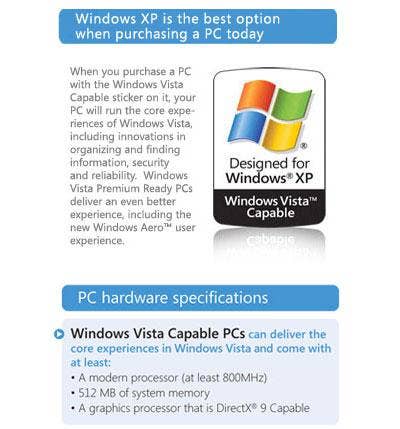
Aside from showing us that Microsoft executives are pretty bad at spelling, the electronic discovery unsealed in the Windows Vista Capable class-action suit offers a startling inside look at the process by which the software giant conceived, strategized and carried out a marketing campaign that ultimately landed it in court.
While the discovery itself is a hodge-podge of e-mails and charts in no chronological order, it's possible to reconstruct the timeline of major events in the Vista Capable campaign. By doing so, we can trace the way Microsoft pushed through OEM resistance and the confusion of its own executives to brand thousands of PCs with the logo of an operating system the computers were not capable of running smoothly without major hardware upgrades.
What we discover is that Microsoft initially planned to run a single Vista marketing program ahead of the new operating system's launch, one that labeled PCs as 'Ready' to run Vista only if they met the hardware requirements for doing so. The problem was that not many PCs had the right hardware, so Microsoft concocted a confusing 'two-tier' marketing campaign that added a second, lower threshold category called 'Vista Capable.'
Unfortunately, Vista Capable PCs weren't really capable of running Vista. Microsoft's rationale was that a hardware upgrade on Vista Capable PCs would make them capable of running Vista.
While the Vista Capable addition led to far more PCs on retail shelves and elsewhere getting a Vista logo, it also resulted in a great deal of resistance and confusion on the part of Microsoft's OEM and retail partners, and even among its own executives and sales staff.
And ultimately, it resulted in a class-action lawsuit brought by consumers against Microsoft, as owners of PCs with Vista Capable stickers discovered that their purchases weren't capable of running much of Vista at all.
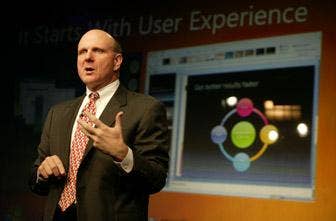
The Microsoft employees involved in the Vista Capable campaign go all the way to the top, CEO Steve Ballmer. Executives from the Redmond, Wash.-based software giant named in the following timeline are listed below, with our best estimates of their job titles during the course of the roughly two-year period charted in the unsealed discovery. Non-Microsoft employees appearing in the discovery are described as is relevant. All images originate from Exhibit A in Dianne Kelley and Kenneth Hansen v. Microsoft Corporation, proceeding at U.S. District Court in Seattle.
The main Microsoft employees named in the timeline are: Jim Allchin, Group VP, Platforms Group; Bob Aoki, Developer and Platform Evangelism; Steve Ballmer, CEO; David Berett, Group Manager, Retail Business Development; Shanen Boettcher, Vista product manager; Brad Brooks, CVP for Windows Consumer Product Marketing; Eric Charbonneau, MCSE and author, Eric Charbonneau's Direct Reports; Mark Croft, marketing director; Gregg Daugherty, business analyst, Hardware Group; Jon DeVaan, SVP, Engineering Strategy; Scott Di Valerio, VP, Corporate Controller; Kevin Eagan, GM, OEM Marketing; Jim Hebert, GM, Windows Server Product Management Group; Will Johnson, unknown executive or associate; John Kalkman, GM, OEM and Embedded Engineering; Anantha Kancherla, unknown executive or associate; Patrick Kennedy, unknown executive or associate; Jawad Khaki, CVP, Windows Hardware Ecosystem; Steven Leonard, account manager; Mike Nash, CVP, Windows Product Management; Will Poole, SVP, Windows Client Business; Owen Roberts, Sr. Director, Sales, Home and Retail Division; Robert Rutledge, Account Manager, Wal-Mart; Jon Shirley, member, Board of Directors; Mike Sievert, CVP, Windows Product Marketing; Steven Sinofsky, SVP, Windows and Windows Live Engineering Group; Carl Sittig, GM, OEM Americas; Rajesh Srinivasan, marketing director; Hakon Strande, project manager, Windows Audio/Video Excellence Team; Rick Thompson, corporate VP, Windows Live Advertising and Monetization Platforms; Bill Veghte, SVP, Online Services and Windows Business Group; Padmanand Warrier, Director of Mobile Services, Windows Mobile; Mike Ybarra, director of product management; Stephanie Ybarra, OEM account manager for Dell; Dina Yershova, unknown executive or associate.
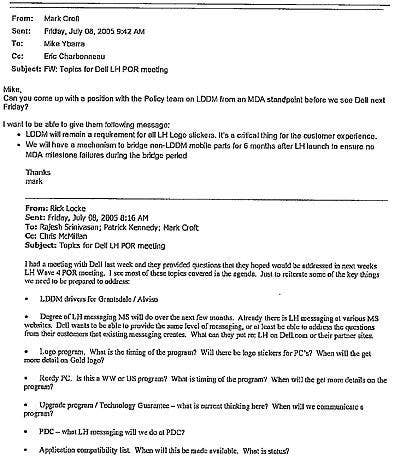
March-April, 2005
Rajesh Srinivasan refers to this period in an Aug. 9, 2005 e-mail as a time when a two-tier Vista marketing program was initially floated, but back then 'we did not believe we can finely message a two tier program to customers'. Eventually, discussions with Best Buy would convince Srinivasan to push for a 'Vista Capable' campaign that would put the Vista logo on PCs that could only run a barebones version of Vista. (pg. 135)
July 8, 2005
Mark Croft, in an e-mail to Mike Ybarra and Eric Charbonneau about an upcoming meeting with Dell, is still referring to Vista's codename Longhorn when he notes that LDDM (later re-designated Windows Display Drive Model or WDDM) 'will remain a requirement for all LH Logo stickers.' WDDM would be dropped as a requirement for the Vista Capable logo campaign in the January, 2006 timeframe. Without the WDDM requirement, systems wouldn't be able to run Aero, the major Graphic User Interface development that delivered what Microsoft marketed as 'the Vista experience'. (pg. 29, pictured)
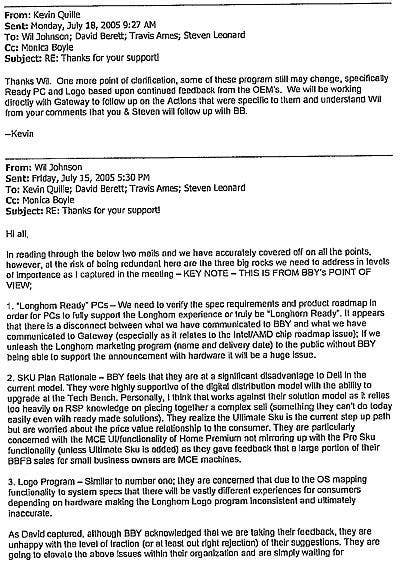
July 15, 2005
Will Johnson refers to 'Longhorn Ready' PCs and Best Buy's issues with hardware support ahead of the launch of the still-developing Vista marketing campaign, 'especially as it relates to the Intel/AMD chip roadmap issue'. Already, concerns were being expressed that available hardware wouldn't support the new Vista OS. (pg. 140, pictured)
Aug. 5, 2005
Eric Charbonneau addresses apparently separate 'Vista Ready' and 'Vista Logo' marketing programs in an e-mail bulletin. At that point, 'LDDM capable graphics solutions' (necessary to run Aero) would be 'required for both the Vista Ready and the Vista Logo program.' Meanwhile, systems built on Intel's 915 chipset 'will not be eligible for the Windows Vista Ready designation.' (pg. 28)
When the Vista Capable category was added to the Vista marketing plan, the 915 chipset would be eligible for Vista branding. That chipset would become a major bone of contention between Microsoft executives during the year before Vista's launch.
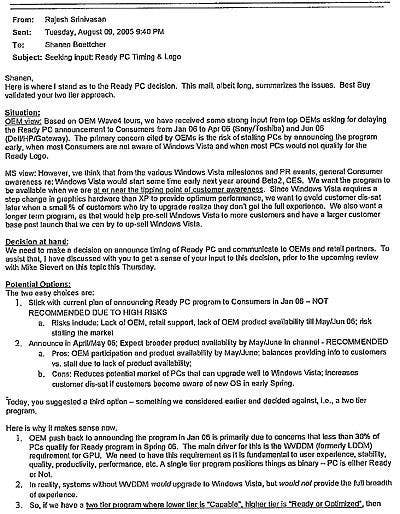
Aug. 9, 2005
The birth of the Vista Capable campaign may be seen in a long e-mail from Rajesh Srinivasan to Shanen Boettcher, whom Srinivasan credits with conceiving the 'two tier approach.' 'Best Buy validated your two tier approach,' Srinivasan writes, explaining that 'it makes sense now' to 'have a two tier program where lower tier is "Capable", higher tier is "Ready or Optimized". (pgs. 134-5)
In Srinivasan's vision, WVDDM (later shortened to WDDM) capability would not be necessary to stamp a system 'Capable'. It would be five to six more months before Microsoft officially dropped its WDDM requirement from the Vista Capable logo campaign. But the seeds had been laid for putting the Vista logo on PCs that couldn't even run the Vista-defining Aero GUI.
Ultimately, the appeal of the Srinivasan-Boettcher two-tier Vista logo program, per Best Buy, was that it 'addresses 100% of PCs'. That meant that the Vista brand could be associated with the '70-80% of PCs' that Srinivasan estimated would lack the hardware to run the full version of the operating system at the launch of the Vista Capable campaign in 'early Spring 06'.
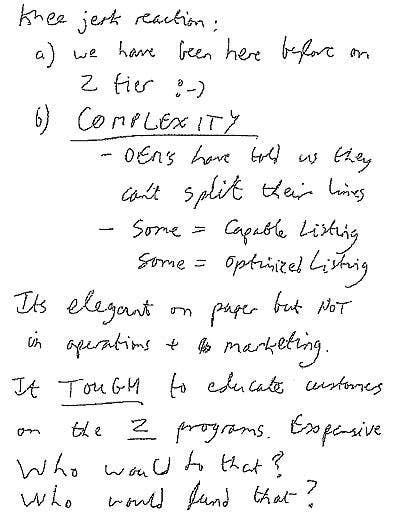
Aug. 10, 2005
Rajesh Srinivasan, in an e-mail to Kevin Eagan and Mark Croft, passes along his opinion that 'it makes sense now' to move from the single Ready PC marketing strategy to 'a two-tier program where the lower tier is "Capable," higher tier is "Ready or Optimized."' (pgs. 7-8, 135)
Croft, in what looks like a hand-written fax to Srinivasan, writes that the proposed two-tier Vista campaign is 'elegant on paper but NOT in operations + marketing.' (pg. 6, pictured)
In a reply to Croft, Srinivasan describes Vista Home Basic as 'Windows 2006', a seemingly dismissive term for the limited operating system upgrade that would later become the core of the entire Vista Capable campaign. Srinivasan also opines that 'we are allowing Intel to milk 915, while allowing and paying OEMs to deliver a poor Windows Vista experience.' (pg. 5)
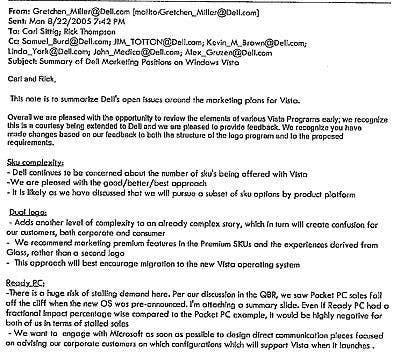
Aug. 22, 2005
Gretchen Miller, director of mobile product marketing at Dell, warns Carl Sittig and Rick Thompson that the proposed dual logo program 'will create confusion for our customers, both corporate and consumer.' (pg. 26, pictured)
Oct. 11, 2005
Padmanand Warrier, e-mailing Rajesh Srinivasan and others, is concerned that in the midst of a planned campaign 'touting the benefits of _premium_ Vista,' customers will be buying logo'd PCs that 'will not even meet the requirements for running _standard_ Vista.' 'That's just bad,' Warrier comments. (pg. 146)
Nov. 3, 2005
Brad Goldberg confirms to Jim Hebert and others that, 'There is no marketing budget associated with this [Vista Capable] program.' It seems reasonable to wonder how Microsoft thought it was going to educate consumers about the limitations of Vista Capable-stamped PCs without spending any money to do so. (pg. 153-4)
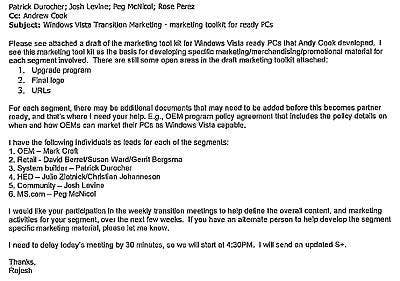
Nov. 3-30, 2005
Friction appears between executives and associates responsible for marketing Vista Capable. Mark Croft tells Brian Goldberg and Kevin Eagan that 'I do not like the tone from Jim [Hebert],' referring to complaints from Hebert about the difficulties of explaining Vista Capable to OEMs. (pgs. 152-4)
Nov. 8, 2005
Srinivasan announces the leads on marketing Vista and Vista Capable for various segments. These are: Mark Croft (OEMs), David Berret/Susan Ward/Gerrit Bergsma (retail), Patrick Durocher (system builders), Julie Zlotnick/Christian Johanneson (HED), Josh Levine (community) and Peg McNichol (MS.com). (pg. 129, pictured)
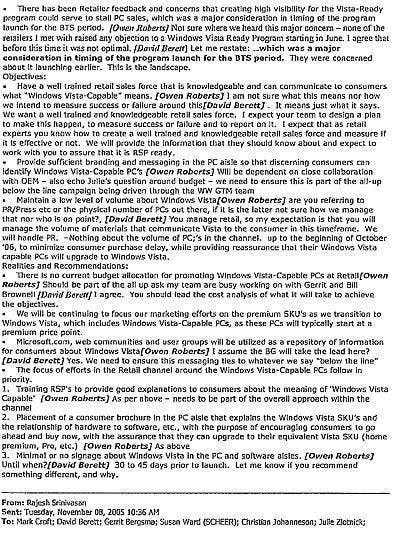
Nov. 9, 2005
David Berett, in an e-mail briefing Owen Roberts, Rajesh Srinivasan, Mark Croft and others on 'Windows Vista Transition Marketing,' recommends 'minimal or no signage about Windows Vista in the PC and software aisles' at retail outlets, until '30 to 45 days prior to launch.' (pgs. 127-28)
Given that the class-action suit against Microsoft hinges on whether consumers were reasonably informed about Vista and the limitations of Vista Capable-labeled systems, this would seem to be important. A later e-mail from Robert Rutledge to Wal-Mart counterparts, sent less than two months before Vista's retail launch on Jan. 31, 2007, reinforces Microsoft's strategy of 'doing very little to drive demand and awareness for Windows Vista until CES.'
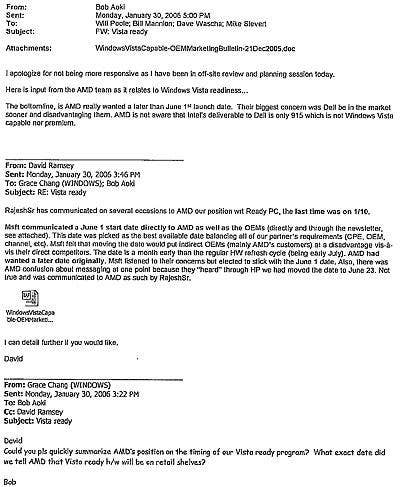
Jan. 30-31, 2006
Bob Aoki informs fellow executives via e-mail that Advanced Micro Devices wants the Vista Ready/Capable program to launch later than the proposed June 1. According to Aoki, 'Their biggest concern was Dell be in the market sooner and disadvantaging them. AMD is not aware that Intel's deliverable to Dell is only 915 [chipset] which is not Windows Vista capable nor premium.' (pg. 68, pictured)
In a long back-and-forth between executives, Microsoft tries to figure out how to spin Hewlett-Packard on dropping the WDDM graphics requirement for Vista Capable systems, given 'the investment that HP has made in supporting the Windows Display Drive Model [WDDM]' needed to run Aero and other higher Vista functions. (pgs. 36-46)
This marks a crucial point in the Vista Capable campaign, when Microsoft essentially gave up any requirement that a Vista Capable PC be able to actually run the major features of the OS. Chipsets like Intel's 915 that didn't support the WDDM graphics necessary for Vista's new GUI would still be branded with a Vista Capable logo for consumers.
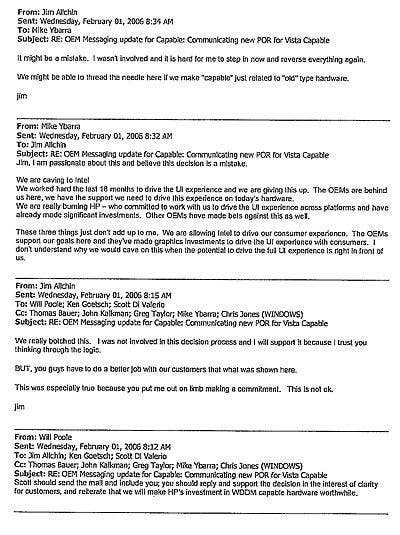
Feb. 1, 2006
'We are caving to Intel,' writes Mike Ybarra in an e-mail to Jim Allchin that refers to the decision to drop the WDDM requirement for systems receiving a Windows Vista Capable logo. 'We are really burning HP -- who committed to work with us to drive the UI experience across platforms and have already made significant investments.' (pg. 35, pictured)
Dina Yershova tells Owen Roberts and others that 'by removing WDDM requirement we are in danger of disappointing many customers regarding the full Vista experience if they choose to upgrade after we launch. Not sure who the call was with, but this is very concerning.' (pg. 133)
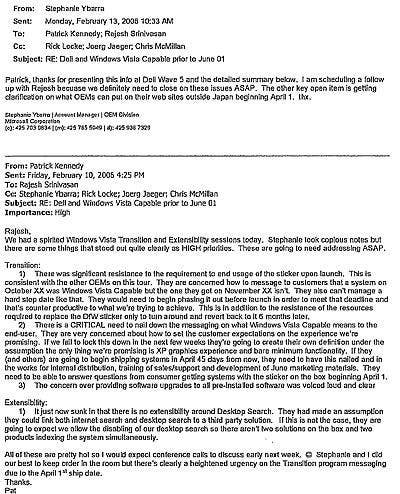
Feb 10, 2006
Rajesh Srinivasan, in an e-mail to Patrick Kennedy, hints at some problem with Vista Capable logo'd PCs listed on Dell's Web site, possibly another hardware requirement issue that 'is being slowly resolved with HP -- Don't address this at Dell if you can avoid it.' Although the 'Dell site is not OK strictly', Srinivasan informs Kennedy that 'KevinE [Kevin Eagan?] is saying Dell site is now OK.' (pg. 130)
Meanwhile, Kennedy briefs Srinivasan and others about OEM concerns about the Vista Capable campaign. These include 'significant resistance to the requirement to end usage of the sticker upon launch', and 'a CRITICAL need to nail down the messaging on what Windows Vista Capable means to the end-user'. Kennedy warns, 'If we fail to lock this down in the next few weeks they're going to create their own definition under the assumption the only thing we're promising is XP graphics experience and bare minimum functionality.'
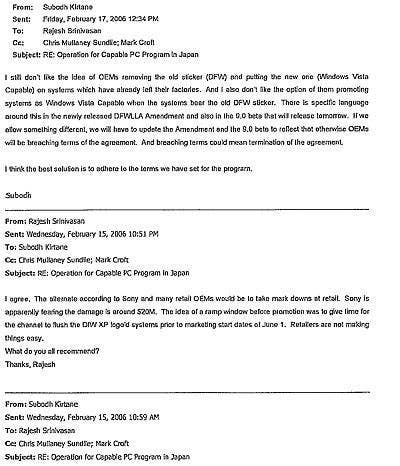
Feb. 15, 2006
Rajesh Srinivasan, to Mark Croft and others, says that Sony 'estimates its exposure at 90K systems' and fears 'damage around $20M' due to potential retailer mark-downs of systems not labeled 'Vista Capable' before an April 1 deadline. (pg. 98, pictured)
Extrapolating from Sony's numbers to those likely to belong to other OEMs, it seems pretty clear that millions of PCs and hundreds of millions of dollars were caught up in the Vista Capable debacle.
Feb. 28, 2006
Analyst Gregg Daugherty expresses concerns to Microsoft executives about 'the ultra cheap laptop phenomena,' wondering whether Vista system requirements might not be in step with a shift to low-cost hardware. He asks: 'Are our assumptions/predictions of the take rate of [Vista] Premium too high, because we've missed the impact of a shift to cheap laptops?' (pg. 65-66)
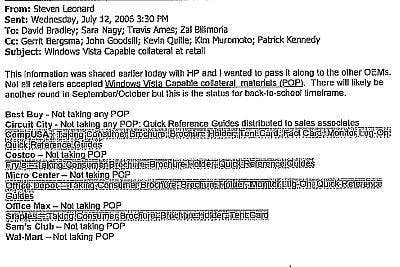
March 1, 2006
Answering Rajesh Srinivasan's question as to whether older Intel 865 chipsets would qualify for Vista Capable PCs, Anantha Kancherla replies: 'Based on objective criteria that exists today for capable even a piece of junk will qualify So based on that yes 865 will qualify.' (pg. 137)
July 12, 2006
Steven Leonard passes along data that of 11 big-box retailers, seven aren't accepting Windows Vista Capable collateral materials (POP) to educate sales associates on the nuts and bolts of the logo program. How those retailers' customers were supposed to make sense of the Vista Capable logo on PCs they were purchasing is suitably vague. (pg. 86, pictured)
Aug. 10, 2006
In an e-mail describing confusion about the Vista Capable logo campaign at Best Buy, Steven Sinofsky writes, 'We set ourselves up.' (pg. 2)
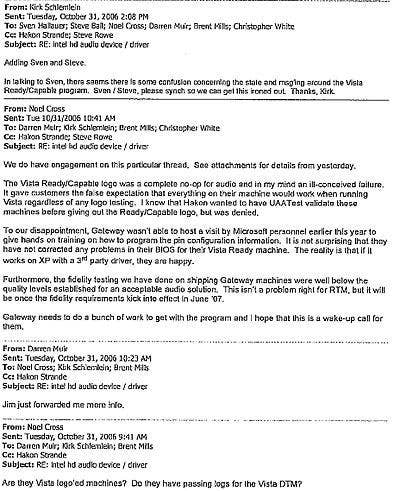
Oct. 31, 2006
Hakon Strande opines: 'The problem with the "Capable" program is that the customer who buys a "Capable" machine and Vista retail does not know that "Vista Capable" != everything just works.' (pg. 89)
Strande's note is in response to colleague Noel Cross's contention that, 'The Vista Ready/Capable logo was a complete no-op for audio and in my mind an ill-conceived failure. It gave customers the false expectation that everything on their machine would work when running Vista regardless of any logo testing. I know that Hakon wanted to have UAATest validate these machines before giving out the Ready/Capable logo, but was denied.' (pg. 90, pictured)
The question becomes, what Vista features were actually tested on Vista Capable-stamped PCs?
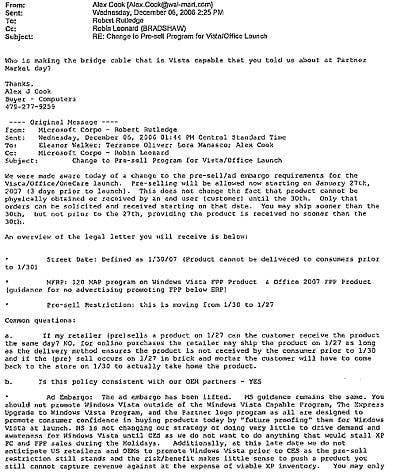
Dec. 6, 2006
Robert Rutledge tells Wal-Mart counterparts: 'MS is not changing our strategy of doing very little to drive demand and awareness for Windows Vista until CES as we do not want to do anything that would stall XP PC and FPP sales during the Holidays.' (pgs. 122, pictured, and 123)
This lends support to the theory that David Berett's recommendation more than a year earlier for 'minimal or no signage about Windows Vista' until '30 to 45 days prior to launch' was carried out, possibly adding weight to plaintiffs' complaint that they weren't adequately informed about Vista and Vista Capable limitations.
Dec. 11, 2006
In an e-mail to colleagues, Faith Chenault of Dell's Software Product Marketing team describes Microsoft counterpart Stephanie Ybarra's Vista Capable explanation as, 'Clear as mud, right?' (pg. 58)
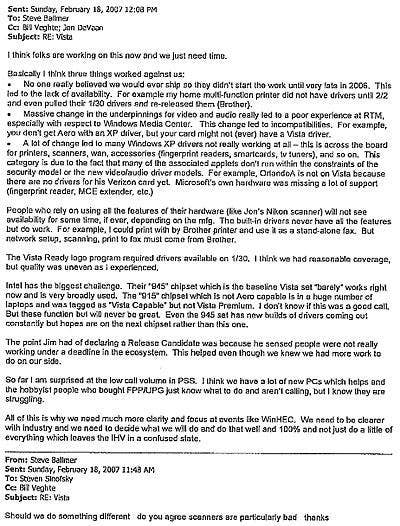
Feb. 18, 2007
'You are right that people did not trust us,' Steve Ballmer replies to Jon Shirley, answering Shirley's contention that OEM and developers didn't do enough driver testing on Vista's beta release because they were skeptical about the OS. (pg. 33)
Steven Sinofsky briefs Steve Ballmer, Bill Veghte and Jon DeVaan on things that 'worked against us' with regards to Vista marketing. Included is the comment that 'Intel has the biggest challenge. Their "945" chipset which is the baseline Vista set "barely" works right now and is very broadly used. The "915" chipset which is not Aero capable is in a huge number of laptops and was tagged as "Vista Capable" but not Vista Premium. I don't know if this was a good call.' (pg. 32, pictured)
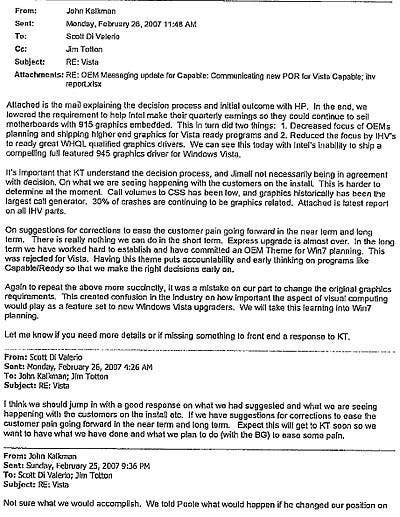
Feb. 25, 2007
Mike Nash informs Scott Di Valerio, Bill Veghte, Mike Sievert, Brad Brooks and Jawad Khaki, that 'I personally got burned by the Intel 915 chipset issue on a laptop that I PERSONALLY (eg with my own $$$). [sic] I now have a $2100 email machine.' (pg. 31)
Feb. 26, 2007
John Kalkman, in an e-mail to Scott Di Valerio and Jim Totton, VP of software for Dell's Client Product Group, writes that 'we lowered the requirement to help Intel make their quarterly earnings so they could continue to sell motherboards with 915 graphics embedded.' Upon the unsealing of the discovery in the Vista Capable suit, Intel legal affairs spokesman Chuck Molloy rejected that claim, telling ChannelWeb: 'My reaction to that statement is that John Kalkman has zero visibility into Intel's financials, financial forecasting or any financial situation as it relates to Intel's motherboards or any other product we sell.' (pg. 30, pictured)
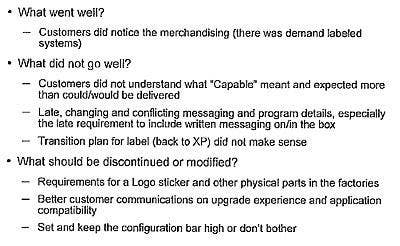
March 25, 2007
In a 'Windows Vista Post Mortem' document from Dell that was apparently circulated to Microsoft, the assessment by Dell was that 'Customers did not understand what 'Capable' meant and expected more than could/would be delivered.' (pg. 14)
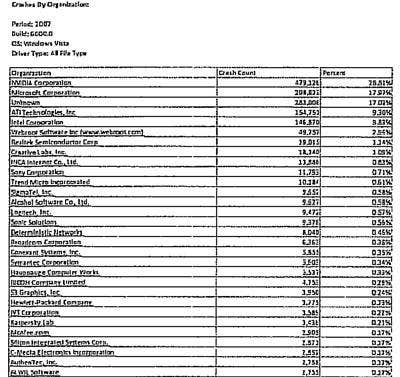
Unknown date, 2007 or 2008
Starting on pg. 47 (pictured) of the discovery is a list of driver crashes in Vista compiled by Microsoft for 'Period: 2007'. Whether that represents all or just part of 2007 is unclear. Also somewhat ambiguous is how the crash list was generated, though most agree that the numbers were gathered from users sending prompted reports to Microsoft following driver-caused application or system crashes in Vista. What is clear is that Nvidia is responsible for nearly 29 percent of the crashes on the list, giving weight to a host of complaints about the graphic chip maker's drivers in the first few months following Vista's release. (pgs. 47-53)